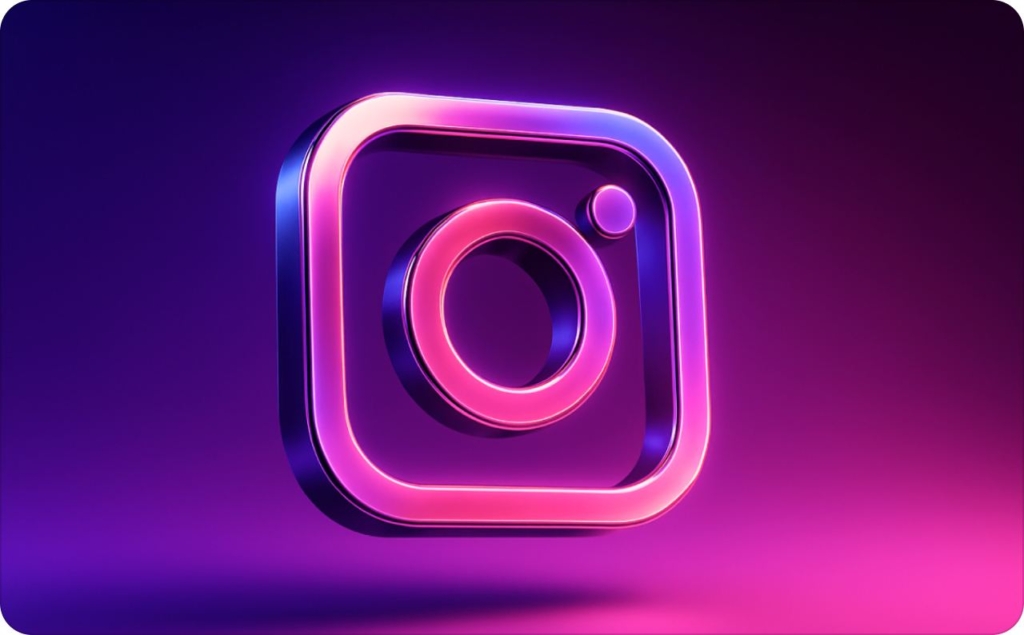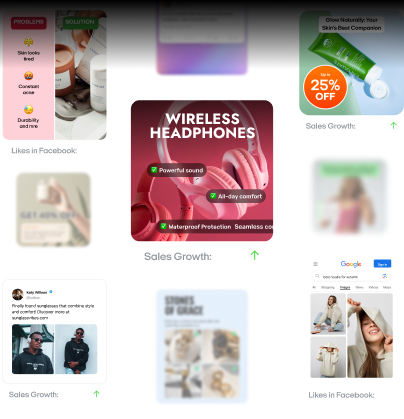8 types of digital advertising: Choose the best options for your campaigns
Confused about which digital ad type fits your goals? Zeely AI breaks down eight main types of digital advertising — with insights to help you choose smarter and spend better.
Most brands still pour money into broad TV spots that can’t prove their worth. Digital advertising solves that problem by showing a laser-focused message to one person at a time — and recording every click, swipe, and sale.
Digital advertising is the practice of buying and placing paid online ads across search engines, social platforms, email, and mobile apps. According to Statista, global digital ad spend is projected to hit 694 billion USD in 2024, a surge driven by wider internet access and nonstop demand for online content.
When you launch a campaign, you bid in real time on Google Ads or Meta Ads Manager, decide who sees the creative, and track every action in a dashboard that refreshes in seconds. Those live numbers let you shift budget on the fly — something traditional media can’t match.
TV, print, and radio blast one message to everyone and wait weeks for vague results. Digital campaigns, by contrast, pair tight audience segmentation with precise ad measurement. You see which keyword converts, which video stalls, and exactly how much each customer costs.

Why digital advertising matters
Digital advertising matters because it gives you precision, speed, and proof — advantages no billboard or TV spot can match. Programmatic makes the channel even sharper. Programmatic is software that buys individual impressions in real time, and it fuels the biggest digital advertising trends 2024. It now captures almost every new display dollar worldwide — roughly 96 % of growth.
Precise audience targeting keeps costs low. When you exclude mismatched segments, CPC and CPM drop fast. One local retailer swapped newspaper inserts for Facebook retargeting and cut CPA by 28 % within a month.
Live dashboards supply instant feedback. Open Google Ads or GA4 and track return on ad spend; if ROAS slips, pause or tweak creative on the spot. These real-time performance metrics power data-driven marketing.
Mobile reach multiplies those gains. Apps will absorb about 82 % of mobile ad budgets this year, so meet users where they scroll. Video thrives there: A/B tests show TikTok video ads deliver up to 47 % higher click-through rates than static images, justifying the extra shoot cost.
Yet digital ad challenges lurk. According to WordStream, average display CTR sits at 0.46 %, so most impressions never earn a click. Watch for a 20 % week-over-week CTR drop — your early warning that ad fatigue is setting in. Rotate visuals, set frequency caps, and lean on cost-effective digital ad strategies like target-CPA bid limits to defend ROI.
New? Start simple: open Google Ads, pick one goal and let Smart Bidding handle bids. With the why now clear, let’s zoom in on the concrete advantages you can unlock next.
Overview of digital advertising types
This overview of digital ad formats maps the main advertising channels in digital marketing. Search, banner, in-stream video, podcast spots — all sit under the wider label digital advertising. Each format carries its own price, targeting logic, and user feel, so picking the right mix protects ROI.
What search engine marketing does for you
Search Engine Marketing places paid ads on Google, Bing, and other search engines so your offer appears above organic listings when someone types a query you bid on. Because you pay only when a visitor clicks, SEM targets shoppers who already show intent. A 2024 StoreGrowers study pegs the average search conversion rate at 2.9 %, far higher than display averages. This precision makes SEM a primary lever for high-intent traffic acquisition and measurable ROI.
How PPC auctions and CPC pricing work
Each time a query fires, Google runs an instant auction that ranks ads by max bid × quality score. You set a bid limit and use negative keywords to block irrelevant traffic. Lower relevance means higher CPC, so fine-tuning ad copy and keyword match types protects budget.
Four best practices for cost-efficient SEM
- Research keywords with at least 500 monthly searches and commercial intent
- Cluster ad groups by theme; tight groups raise quality score and lower CPC
- Schedule ads when your audience converts
- Monitor search-term reports weekly; add negatives to cut wasted spend and re-allocate bids to high-ROI phrases. Brands that follow this loop reduce CPA by 15 % in two months
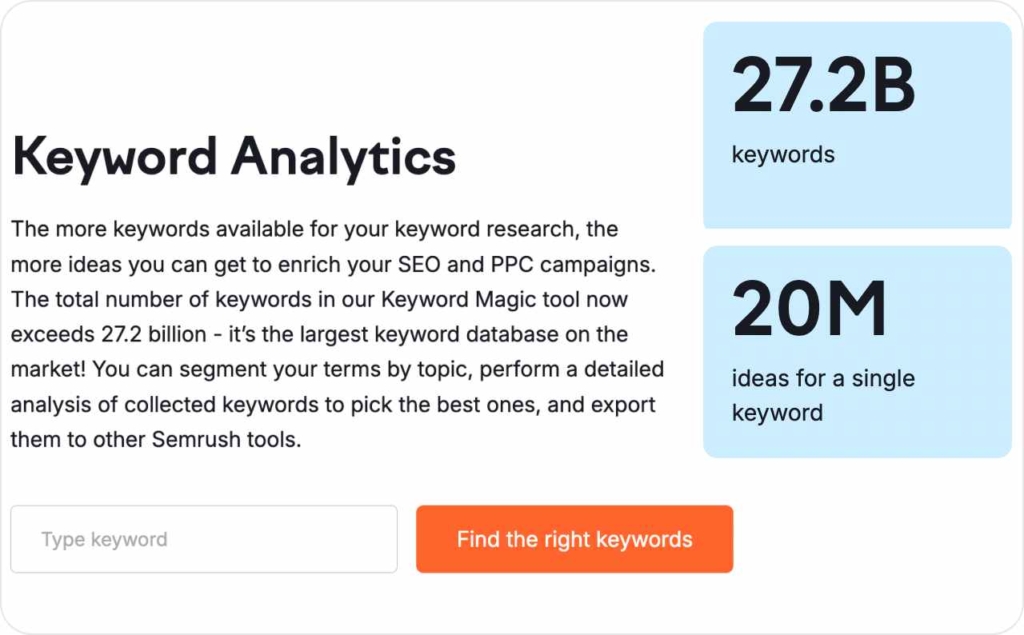
Photo source: SEMrush
What counts as display advertising
When you buy ad space on the Google Display Network or any large ad exchange, you’re investing in display advertising. Core formats you’ll encounter include static banners, animated GIFs, expandable units, and interstitials that appear between page loads. Newer options such as rich-media and interactive display ads add video, gestures, or live pricing feeds so users can act without leaving a page. No matter the format, you pay on a CPM or CPC basis and rely on imagery to capture attention. A display ad generator uses AI to automatically create visually engaging banner and sidebar ads tailored to your brand and target audience. It ensures each ad fits platform-specific dimensions and optimizes layouts, colors, and messaging to boost click-through rates.
Display formats
If you need a quick brand lift, deploy banner ads; Lenovo’s 300 × 600 skyscraper lifted aided recall 17 %. To double engagement, Nike swapped static images for animated GIFs and saw CTR rise from 0.3 % to 0.6 %. Looking for direct sales?
Shoppable rich-media banners let shoppers add items to cart instantly. Expandable ads reveal product carousels on hover — ideal when you showcase multiple SKUs. For full-screen impact, gaming apps run interstitial ads and hit 10 % conversion with tight frequency caps.
Your engagement challenge
Standard banners average just 0.46 % CTR. Users skim past repetitive creatives, and ad-blockers thin your reach. Programmatic retargeting lifts relevance yet performance drops after about 14 impressions. If you don’t track frequency and freshness, your spend erodes.
Design and placement best practices
- Refresh creative every two weeks to keep your ads from going stale
- Use one bold focal point; clutter trims CTR by 29 %
- Target by context and demographic — placing ads near relevant content lifts viewability above 70 %
- Cap frequency at 5–8 impressions per user; more sparks fatigue
- Bid on viewable CPM so at least half the ad stays on-screen one second
Social media advertising at a glance
Social media advertising places paid messages inside the feeds, stories, and short-video streams of platforms such as Facebook, Instagram, TikTok, LinkedIn, and X. Unlike search, each network controls its own ad inventory so format choice shapes both reach and cost. Because every slot lives inside a user’s personal timeline, social ads excel at brand storytelling and real-time engagement.
How targeting works on major platforms
Each platform turns user data into interest graphs. On Meta properties, you can combine demographic filters with look-alike audiences that mirror your current buyers. TikTok’s “Creative Center” shows trending sounds to refine cultural fit, while LinkedIn layers job title and company size for precise B2B outreach. Meta Ads Manager and TikTok Ads Manager display live CPM and CPA, letting you adjust bids or budgets in minutes instead of days.
Platform-specific ad formats you can deploy
- Facebook & Instagram: single images, carousels, Reels, and Story ads; best for multi-objective funnels
- TikTok: 9–15-second vertical videos with sound-on autoplay; excels at viral reach
- LinkedIn: Sponsored Content and Conversation Ads that appear in the message inbox; ideal for lead generation
- X: Promoted Tweets and Trend Takeovers for time-sensitive topics
Match creative length, aspect ratio, and tone to the platform: a static infographic may perform on LinkedIn but flop on TikTok, where motion rules
Focus on impressions, click-through rate, and cost per acquisition as your core KPIs. Regular testing and adjustment transform social campaigns from experimental spend into predictable revenue.
Why you should invest in video ads
If you want brand stories to stick, video advertising is your fastest lane. Motion, sound, and narrative boost recall far beyond static banners, letting you build immersive storytelling that nudges viewers toward action. Keep the core vocabulary so search engines link your campaign to standard IAB units. When you own the screen and the soundtrack, dwell time climbs and consideration deepens.
Pick the video format that fits your goal
Choose format before pressing record. In-stream ads run before, during, or after content on YouTube and Hulu; short pre-roll works best for awareness. Need reach outside long-form video? Out-stream units autoplay in news articles and social feeds. Selling on the living-room screen? CTV ads show full-screen on smart TVs and pair with companion banners on mobile for a two-device punch. Each slot carries its own pricing and context, so match the format to the funnel stage and platform where your audience already hangs out.
Create video ads that convert on every screen
Hook viewers in the first three seconds and keep your file under 2 MB for fast mobile load. Produce multiple aspect ratios — 16:9 for YouTube, 9:16 for Shorts and TikTok, 1:1 for Facebook feeds. Always burn in captions; most social users watch muted. Cap frequency at three touches per week to avoid ad fatigue, then bid higher on placements beating your target CPCV. When you follow these platform-optimized steps, expensive video inventory turns into a conversion-centric, high-intent campaign that justifies every production dollar. An AI-powered video ad maker automatically creates videos in the perfect sizes and formats for platforms like Instagram, TikTok, and Facebook. It ensures each ad fits the platform’s requirements while optimizing resolution and length for maximum impact. This smart automation saves time and guarantees your ads look professional and perform well across all channels.
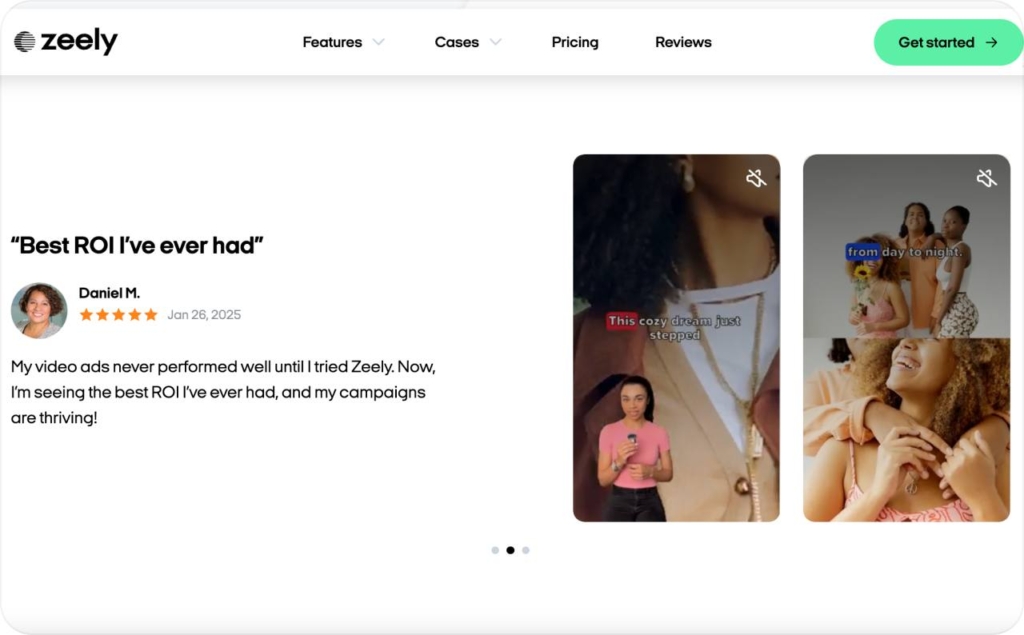
Native advertising: What you need to know
When you run a native ad, the paid unit copies the host site’s font, layout, and tone, so it reads like part of the editorial flow. That styling trick explains why native advertising beats banner blindness and slips past most ad-blockers. Sharethrough reports users spend 40 % more time on native placements than on standard display. By linking your brand story to credible editorial content, you gain trust without shouting “Buy now.”
Formats you can deploy today
Native breaks down into three main options: sponsored content, in-feed ads, and recommendation widgets. Sponsored content lets you publish a full article. In-feed ads appear inside LinkedIn or Facebook timelines, matching headline length and image ratio. Recommendation widgets from Outbrain or Taboola sit below articles with “You Might Also Like” teasers. Each format inherits the publisher’s CSS, so your ad feels organic, not intrusive.
How you keep native ads honest and engaging
Match headline syntax, thumbnail size, and byline placement to the host’s style guide. Use contextual keywords that mirror surrounding articles; relevance bumps viewability by 25 %. Limit your logo to one subtle mark and label the unit “Sponsored” for compliance. Finish with a single, low-friction call-to-action — “Read the full report” converts better than “Shop now.” Follow these rules and you’ll integrate, not interrupt, the reader journey.
Why mobile advertising matters
If you target users who spend five hours a day on smartphones, mobile advertising becomes your quickest path to attention and action. The channel covers any paid creative delivered inside an app, on a mobile web page, or by SMS. Because every tap happens on a small screen, success depends on responsive design, compressed assets, and thumb-friendly calls-to-action.
Core mobile ad formats
Mobile inventory breaks into four high-impact formats: in-app display, playable ads that let gamers test a level before download, rewarded video that grants virtual currency after a full watch, and SMS promotions for direct opt-in messaging. Each format serves a distinct purpose. Playables drive app installs by giving users a risk-free preview.
Design for engagement on small screens
Use a single focal point, high-contrast text, and tap-safe buttons at least 44 × 44 px. Place headlines in the top 20 % of the frame, where eye-tracking studies show the fastest fixation. If you localize creatives, preview on both iOS and Android to prevent layout shifts. Responsive creative optimization isn’t a luxury; it’s the cost of entry when screen real estate is scarce.
Why email advertising still works
Email advertising sends promotional messages directly to an opted-in inbox, bypassing social algorithms and search auctions. Delivery happens inside a permission-based channel, email excels at nurturing customer relationships, announcing limited-time offers, and driving repeat purchases.
List segmentation and personalization
Effective campaigns start with list segmentation. Break subscribers into cohorts by purchase history, location, or engagement level. Then customize subject lines, product recommendations, and send times for each segment. Use merge tags for names and conditional content for offers, ensuring every reader sees a message relevant to their behavior.
Crafting high-performance email creatives
Keep creative lean for mobile screens: one hero image under 100 KB, concise copy, and a single call-to-action above the fold. Match brand colors to boost recognition, but leave 20 % blank space to avoid spam filters. Use a pre-header that extends the subject line’s promise, and follow a 60/40 text-to-image ratio so spam algorithms can parse the message. A/B test subject lines and CTAs; declare a winner after 1 000 opens to ensure statistical confidence.
Audio ads reach listeners you can’t see
Audio advertising delivers brand messages when people jog, commute, or cook — moments screens can’t reach. Spotify, Apple Podcasts, and Amazon Music insert ads directly into streams, giving you uninterrupted ear-time in a mobile, multitasking context. Pepsi Max on Spotify Free ran a 30‑second audio spot during commute hours, urging listeners to “Crack open a Pepsi Max,” while a companion image appeared on mobile devices featuring a bold “Learn More” button linking to a digital coupon — perfectly aligned with Spotify’s ad specs.
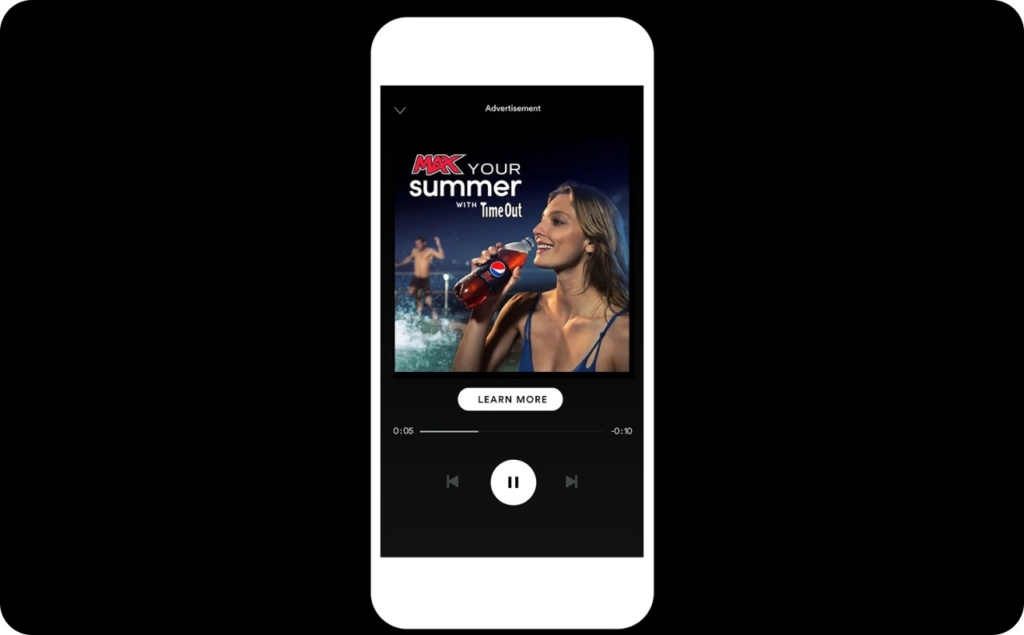
Photo source: Spotify
Podcast, streaming, and voice ads: How they differ
Streaming-audio ads, served between songs on Spotify Free or Pandora, cap at 30 seconds and support companion images on mobile screens. Voice-assistant ads surface through Alexa Skills or Google Actions, prompting users to say “Add to cart” or “Send me a coupon.” Each format occupies a unique engagement window — storytelling for podcasts, reach for streaming, and direct response for voice.
Craft listener-centric creative
Successful audio creative uses one clear benefit in the first five seconds, human voice over background music, and a single call-to-action such as “Visit Example dot com now.” Keep the script under 65 words for a 30-second spot; faster speech drops comprehension. If you target commuters, add geofenced offers — rideshare brands boost redemption by 18 % when CTA references the city name. Brand-safe sound beds and consistent volume ensure your ad blends with podcast production quality.
How to choose the right digital ad format
Choosing a digital ad format is simple once you know your goal, audience, and budget. A digital ad format is any paid creative unit. Follow this proven digital ad selection guide to land on the optimal digital advertising choices for your next campaign.
Define your campaign objective
Every digital ad format excels at one result, so start with the outcome you need. If you want same-day clicks, search text ads dominate because intent is explicit in the keyword. Planning a quarterly brand-lift study? Six- to 15-second pre-roll video or high-impact rich-media display earns top-of-funnel attention and recall. For thought-leadership goals sponsored native stories on Forbes BrandVoice or LinkedIn Articles generate dwell times far beyond banners. Tie every format choice to a single KPI: cost-per-click for search, completed-view rate for video, or scroll-depth for native.
Match format to audience & device
Segment your users with targeted digital advertising by age, interests, and screen size before buying impressions. Teens on TikTok stop for six-second vertical clips with trending audio, while CFOs on LinkedIn engage with 800-word Sponsored Content that digs into ROI tables. Instagram Stories thrive on swipe-up design that fits thumb-first navigation; desktop banners work better for B2B audiences browsing industry blogs during office hours. Feed these segments into programmatic DSPs so the algorithm bids only on qualified impressions, cutting wasted CPM by up to 25 %.
Balance media cost against payoff
Know the going rates: Google Search averages $2–$4 CPC; programmatic display sits at $3–$5 CPM; Facebook carousel hovers near $8 CPM; rewarded mobile video hits $10 CPM; email blasts cost about $0.02 per send. Performance shifts just as widely. Facebook’s 1.57 % CTR doubles the display norm, while email still posts a 19 % open rate. Plot cost versus expected engagement in a matrix so you can spot formats that over-deliver or drain budget.
Guard against creative fatigue
Display CTR often halves after five exposures when the creative never changes. Retargeted banners fight that slide, averaging 0.7 % CTR versus 0.07 % for generic display. Set automated rules: refresh creatives when weekly CTR drops 15 %, or rotate headline-image pairs every 72 hours. For video, swap thumbnails and the first three seconds; on social, alternate primary text to keep relevance high. Active fatigue management preserves reach without buying extra impressions.
Count production effort up front
List every asset before you promise deadlines. Search needs three 30-character headlines and two 90-character descriptions. Display generally requires at least 300 × 250, 728 × 90, and 160 × 600 banners, plus HTML5 for rich media. Vertical video must land between 6 and 15 seconds, include hard captions, and export in 9:16. Native articles demand 600-word copy and editorial-style visuals cleared for brand safety. Estimating the creative workload early prevents launch delays and overtime costs.
Run budget-safe tests
Use Google Performance Planner or Meta Budget IQ to model reach, CPC, and CPA scenarios. Launch two formats with 10 % of total spend for 10 days. Apply a unified conversion window and attribution model so results compare cleanly. When one format beats the other on cost-per-desired-action by at least 20 %, shift an extra 20 % of budget to the winner and pause the laggard. Controlled, time-boxed testing secures quick wins without risking the full media plan.
Sequence formats for maximum scale
Final step: arrange formats in a funnel. Start with search to capture explicit intent. Retarget those warm visitors with dynamic display banners that feature the exact product they viewed. After frequency builds familiarity, layer in 15-second YouTube or CTV spots to widen reach and add storytelling depth. Email or SMS can close the loop with a limited-time offer. This sequential strategy keeps acquisition costs low while compounding touchpoints, turning casual clickers into loyal customers.
Measuring digital ad performance and ROI
Start by tracking three core signals every platform exposes: impressions for reach, click-through rate for interest, and conversion rate for revenue. Add cost-per-click or cost-per-conversion so each number ties to profit. Together, these form the heartbeat of any digital ad performance metrics report.
Tools that evaluate, track, and monitor
Google Analytics 4 links web and app sessions and shows device overlap, revealing users who research on phones and buy on laptops. Meta Ads Manager layers view-through on top of CTR, perfect for video. Free Looker Studio pulls search, social, and programmatic data into one sheet so you can evaluate spend in minutes instead of days.
Attribution: from last click to full journey
Last-click credit hides the real helpers. Switch GA4 to a data-driven model: a five-touch path — YouTube → search → display retargeting → email → branded search — might get 30 / 25 / 20 / 15 / 10 % credit instead of 100 % to that final click.
Fight the analytics pain points
Complexity often peaks at cross-device tracking. GA4’s Device-Overlap report flags where funnels break, letting you tailor mobile creative before budgets bleed. Ad fatigue is another silent killer: display CTR typically halves after 48–72 hours of static creative . Set an alert to refresh when CTR drops 15 % week-over-week.
Turn data into higher ROI
Run a clean A/B test — two headlines, 1 000 clicks each. When the winner beats baseline by 10 %, shift 20 % of spend there and pause the loser. A mid-market SaaS firm followed that rule, discovered YouTube drove 22 % of paid sign-ups, and raised ROAS from 3.1× to 4.0× inside 30 days.
Measure, attribute, optimize — three verbs that turn raw numbers into next quarter’s growth. Now apply these insights to sharper audience and platform choices.
Next steps: Deploying a winning digital ad strategy
You now know the formats, the metrics, and the decision rules. Turn that insight into action with a simple three-phase digital ad strategy:
- Plan. List one goal per campaign — clicks, leads, or sales. Pick two ad formats that fit the goal and audience. Draft a 30-day budget split 70 % proven, 30 % experimental.
- Execute. Launch in Google Ads or Meta Ads Manager. Use responsive assets so creative adapts to every screen. Enable data-driven attribution on day one to capture the full funnel.
- Optimize. Check dashboards daily for CTR, CPA, and ROAS. Rotate creative when CTR drops 15 %. Re-allocate 20 % of spend each month toward the top performer. That loop powers continuous optimization.
Need extra firepower? Tap free tools like GA4’s Explorations, Looker Studio templates, and Meta’s Budget IQ. Join industry forums to swap fresh case studies.
Execute, measure, refine. Follow this cycle and each campaign moves from guesswork to predictable growth. Your next click, test, or creative refresh starts the climb.
Also recommended

